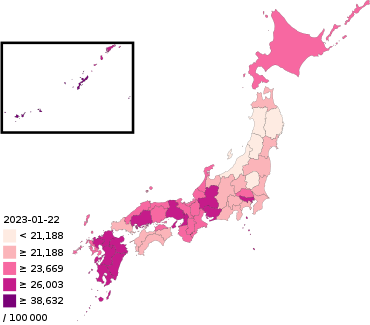| COVID-19 pandemic in Japan | |
|---|---|
 Confirmed cases per million residents by prefecture[a] | |
| Disease | COVID-19 |
| Virus strain | SARS-CoV-2 |
| Location | Japan |
| First outbreak | Wuhan, Hubei, China |
| Index case | Kanagawa Prefecture |
| Arrival date | 16 January 2020 (4 years, 6 months, 1 week and 5 days) |
| Confirmed cases | 16,047[1] |
| Active cases | 6,767[1] |
| Recovered | 8,920[1] |
Deaths | 678[1] |
The COVID-19 pandemic was first confirmed to have spread to Japan in January 2020.[2] Numbers have been recorded in each of the 47 prefectures except for Iwate. The country has seen over 10,000 sick people.
The beginning
[change | change source]The Japanese government said its first outbreak of coronavirus disease 2019 (COVID-19) started on 16 January 2020. The first was a person of Kanagawa Prefecture who had come back from Wuhan, China. The second outbreak was from Europeans and Americans from 11 March to 23 March.
Government response
[change | change source]The Japanese government has tried to stop the outbreak. On 30 January, Prime Minister Shinzo Abe created a national task force to help stop the outbreak.[3]
On 27 February, Abe stopped all Japanese elementary, junior high, and high schools until early April.[4]
On 7 April, Abe set a one-month state of emergency for Tokyo and the prefectures of Kanagawa, Saitama, Chiba, Osaka, Hyogo, and Fukuoka.[5] On 16 April, the declaration was extended to the rest of the country.[6]
2020 Olympics
[change | change source]The pandemic was a problem for the 2020 Summer Olympics. Hhe Japanese government and the International Olympic Committee tried to wait until 2021 before starting the Olympics.[7]
Criticism of the government response
[change | change source]Medical experts and the news have did not like the Japanese government's actions. They said the government was not testing many people for COVID-19.[8] Medical experts said that the government should have used pneumonia surveillance numbers to help very sick patients.[9]
Notes
[change | change source]- ↑ The Kuril Islands are administered by Russia, six cases have been reported in the Sakhalin Oblast overall.
References
[change | change source]- ↑ 1.0 1.1 1.2 1.3 "国内 感染確認96人 100人下回るのは3月30日以来 新型コロナ". NHKニュース. 8 May 2020. Retrieved 12 May 2020.
- ↑ "WHO | Novel Coronavirus – Japan (ex-China)". WHO. Retrieved 2020-03-18.
- ↑ Prime Minister of Japan and His Cabinet (30 January 2020). "Novel Coronavirus Response Headquarters".
- ↑ "PM Abe asks all schools in Japan to temporarily close over coronavirus". Kyodo News.
- ↑ Reynolds, Isabel; Nobuhiro, Emi (7 April 2020). "Japan Declares Emergency For Tokyo, Osaka as Hospitals Fill Up". Bloomberg L.P. Retrieved 7 April 2020.
- ↑ "Japan PM Abe declares nationwide state of emergency amid virus spread". Mainichi Shimbun. 16 April 2020. Archived from the original on 16 April 2020. Retrieved 16 April 2020.
- ↑ "Tokyo 2020 Olympics officially postponed until 2021". ESPN. 24 March 2020.
- ↑ Emiko Jozuka (24 April 2020). "Japanese mayor says men should grocery shop during pandemic as women 'take a longer time'". CNN. Retrieved 30 April 2020.
Since the start of the coronavirus outbreak, politicians have come under immense fire for their handling of the crisis, with many health experts warning of Japan's low testing capabilities and slow government responses. By mid-April, Japan had only tested about 90,000 people, compared with more than 513,000 in South Korea, which has a population of 51 million, compared to Japan's 127 million.
- ↑ Muto, Kaori; Yamamoto, Isamu; Nagasu, Miwako; Tanaka, Mikihito; Wada, Koji (3 April 2020). "Japanese citizens' behavioral changes and preparedness against COVID-19". medRxiv. doi:10.1101/2020.03.31.20048876. S2CID 215782040.